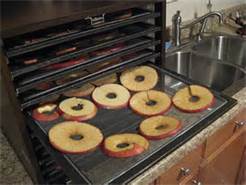Dehydrating Apples

Dehydrating apples is one way to preserve your apple crop and provide nutritious snacks for you and your family. Whether you dehydrate your apples with appliances that use electricity, use the sun or use fire, you follow the same steps to prepare your apples.
Choosing Apples
Different varieties of apples contain different levels of moisture and some are more tart than sweet, so you should choose the variety of apple that you and your family like. Some preppers choose one or two apples of the different varieties to try them before committing to dehydrating several pounds to be sure they like the flavor.
Whatever variety of apple you choose, the individual fruit should be firm and mature. Clean the apples, core them and cut slices or rings about 1/8 to 1/4 inch, taking care to try to cut them as uniform as possible so they dry at the same rate. Some people sprinkle cinnamon on the slices for extra flavor.
Pretreatment
Pretreating the apple slices when dehydrating apples is done frequently to prevent the slightly darkened spots on the apple, which occurs when the flesh is exposed to the air. However, pretreatment also can remove some harmful organisms such as salmonella and E.coli.
You can steam the apples for 3-4 minutes but you must cool off the apples quickly, and blot them dry before beginning the dehydration process. You can use safely ascorbic acids, but the easiest and safest solution if you don't want to steam your slices is to soak the apple slices in lemon, lime or pineapple juice and water in a one to four ratio.
When dehydrating apples, some people do not pretreat their apples. They are confident that they have cleaned the apples thoroughly prior to slicing them, the darkened spots do not bother them and they see no advantage to pretreating. Other people believe that the pretreatment enhances the flavor.
Dehydrating Trays
You arrange your apple slices on trays that can be wooden or metal. If metal you should use a liner of cheesecloth or synthetic curtain material to prevent the metal from reacting with the acid of the fruit. You can buy trays or build them yourself but it is important to have good air circulation between the apples and the trays.
Heat Source
You dehydrate your apples between 135 to 140 degrees Fahrenheit or 57 to 60 Centigrade. If you have an electrical power source, Excalibur, Nesco, Weston and others make dehydrator appliances. However, you can still dehydrate your apples if you are without electricity.
You simply arrange your apple slices on a screen over a low fire or in sunlight. It is very important not to cook your apples, as your goal is to remove the water from them using low heat and circulating air to whisk away the moisture.
Testing
To tell if the apples are dehydrated, place the still warm apples in a plastic bag or glass jar. If condensation occurs at all, the apples are not fully dehydrated. If you are dehydrating apples for long-term storage, you cannot have any moisture left or your apples will spoil and mold. If condensation does occur, simply redo the dehydration process.
Storage
When you are done dehydrating your apples, store them in plastic bags or glass canning jars with metal caps and store them in a dark cool place. Some people put silica gel, which is silicon dioxide in their bagged apples to absorb any type of moisture. This naturally occurring mineral is nontoxic, non-corrosive and is used commercially.
If dehydrating apples is not a process you want to begin right away, the ReadyStore carries a #10 can of Saratoga Farms dehydrated apple slices. If that is too large, Provident Pantry has a 3-ounce can of small apple slices. One thing whether you make your own or you buy them, dehydrated apples are great as a snack on their own, or for using in apple pie, apple fritters or even apple crisp.
Return from Dehydrating Apples to DIY Food Dehydrating





New! Comments
Have your say about what you just read! Leave me a comment in the box below.